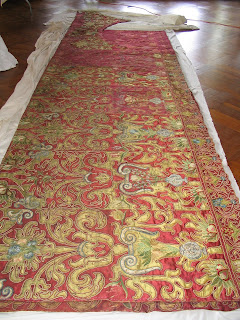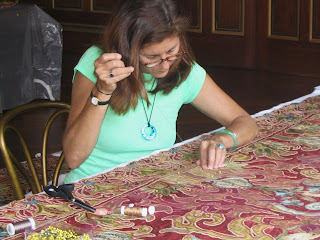Friday, November 18, 2011 -  conservation,Julia Brennan,textiles,Turkey
conservation,Julia Brennan,textiles,Turkey
 No comments
No comments
 conservation,Julia Brennan,textiles,Turkey
conservation,Julia Brennan,textiles,Turkey
 No comments
No comments
Part Two: Conserving the Treasured Wall Fabrics of the Turkish Ballroom 2002-2007
ARCA Washington DC Correspondent
Part two
Atasoy describes that tent makers were divided into groups – those who sewed the tents and others who embroidered. The tent pieces were layers of fabric; the decorations, mostly floral, were cut out of fabric such as satin or silk, to shape the motif such as vase or column. They were sewn onto the backing fabric. A contour around the motif was shaped with a silk cording and sewn onto around the contours to mask the uncut edges and prevent unravelling. This is exactly how these wall fabrics were constructed; with a combination of stitching, glues, appliqués, and embroidery inside the vases. They are also pieced together; with patches inserted around arches, windows, and the stage. There were obviously plenty of pieces on site in order to exactly fit the fabrics into the finished architectural space. The patterns do not all match up – it is a patch work in many curved and small areas.
 |
| Lime encrustations and crepeline overlay from the 1960s |
This was a massive project –- 515 square feet of complex and damaged textiles.
My team set up our workshop in the Residence and stayed for 11 months working, spread out on tables, and up on scaffolding as the seasons passed from blooming dogwoods, shivering cold winter bringing in our heaters, and back into spring, and the blossoming pear trees again. We vacuumed every two days just to pick up the fibers that were flying off the silks. We divided the panels up by location, documented extensively, and then systematically cleaned and repaired. Repairs had to be gross approach and not minute, due to sheer scope of project.
Once all the panels were de installed, then the architects could truly evaluate and see how damaged and porous the walls were. Since the entire house was being renovated, outside masonry work would be done to solve the leaking and stabilize the interior walls. The old crepeline overlays were removed, as well as the later linen backings. Each panel was carefully vacuumed through protective screens to remove surface soiling and dust. This also provided an opportunity to carefully examine each panel, document damage, as well as embroidery and technique.
 |
| Full panel after conservation |
Moreover, this kind of soiling is better cleaned with solvent based applications. All the different fabrics and dyes were tested with the solvent and detergent. An extraction system was employed, pushing and extracting a petroleum-based volatile solvent combined with detergent, through each panel, section by section. Buckets of black solvent were extracted from the panels; a majority of the embedded soiling was removed and many of the dark stains were reduced in appearance.
The repair and stabilization of the fabrics was an eight month process. All the loose cording was re attached with hand stitching. The loose pieces of silk appliqué were re attached with hand stitching, and holes were ‘patched’ using new silk sateen in a similar color. Shredded silk sateen was realigned and couched with hand stitching. The surface silks were still fragile and the weight of the appliqué pulled on the silk ground cloth. Because the panels had to be strong and stable enough to be hung again for a projected fifty years, the decision was made to encase the most fragile of the panels in protective netting. If the panel was predominantly red, then a marroon netting was laid over the panel and hand stitched around the edges, and throughout all the patterning, following the edges of the applied cording and designs. Red and gold netting overlays were applied to about 40% of the panels. This overlay literally holds the silks in place and prevents loss while vertically hanging. The overlays do create a slight ‘veiling’ of the embroidery details and cast a slight red or gold sheen over those treated panels.
Finally, new cotton sateen linings were hand sewn to the back of each panel and fragment. Two inch wide Velcro machine sewn to three inch wide cotton upholstery tape was hand sewn along every edge of each panel, both horizontal and vertical axis. Four years later, when the house was completely renovated, our team returned to install the fabric panels. The walls, fully repaired, were sealed with a vapor and moisture barrier. Two inch wide thin battens were attached to the wall mirroring where the Velcro was on each panel. Two inch wide Velcro hook was stapled to the walls aligning with each strip of Velcro on each panel. One by one, working around the room, the panels were re attached. Finally, a system of low level LED ‘marquee’ lights were installed above and below the panels. This provides a subtle and safe lighting solution.
These textile panels never revealed a name or date, but their construction was telling about a by-gone era and production, as well as a flamboyant architect and his trusting patron. The Turkish Embassy did a great service restoring not only these unusual textiles, but the entire building.
References:
Atasoy, Nurhan. “Otag-I Humanyan: The Ottoman Imperial Tent Complex, Aygaz”, Istanbul, 2000.
Atasoy, Nurhan. “The Ottoman Tent”, www.turkishculture.org
Stone, Caroline. "Movable Palaces", Saudi Aramco World, July/August 2010, pgs. 36-43
Julia M. Brennan



0 comments:
Post a Comment